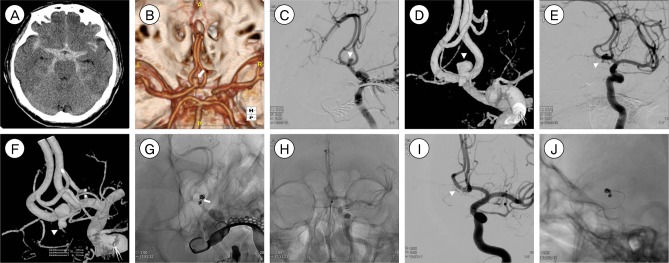J Cerebrovasc Endovasc Neurosurg.
2015 Sep;17(3):209-216. 10.7461/jcen.2015.17.3.209.
Rebleeding of Ruptured Intracranial Aneurysms in the Immediate Postoperative Period after Coil Embolization
- Affiliations
-
- 1Department of Neurosurgery, Kyung Hee University Hospital at Gangdong, Kyung Hee University School of Medicine, Seoul, Korea. realeponym@hanmail.net
- KMID: 2069245
- DOI: http://doi.org/10.7461/jcen.2015.17.3.209
Abstract
OBJECTIVE
Early rebleeding after coil embolization of ruptured intracranial aneurysms is rare, however serious and fatal results of rebleeding have been reported. We studied the incidence and angiographic and clinical characteristics of rebleeding of ruptured aneurysms occurring in the immediate postoperative period after coil embolization.
MATERIALS AND METHODS
We analyzed patients who had aneurysmal subarachnoid hemorrhage and underwent coil embolization. Patients with dissecting aneurysms, blood blister-like aneurysms, fusiform aneurysms, and pseudoaneurysms were excluded. This study included 330 consecutive patients. The clinical and radiological data of 7 of these patients with acute rebleeding after coil embolization were reviewed.
RESULTS
The incidence of rebleeding of ruptured aneurysms after coil embolization was 2.1% (7/330), and all cases of rebleeding occurred in the immediate postoperative period within 3 days after coiling. The radiological characteristics were as follows: anterior communicating artery (ACoA) aneurysm (71.4%, 5/7); presence of intracerebral hemorrhage (ICH, 71.4%, 5/7); dome-to-neck ratio < 2 (42.9%, 3/7); presence of bleb (42.9%, 3/7); and subtotal occlusion of aneurysm after coiling (14.3%, 1/7). A thrombolytic agent was administered in 1 patient and continued anticoagulation was performed in 2 patients. Rebleeding patients showed a very poor outcome (Glasgow Outcome Scale 1, 85.7%, 6/7).
CONCLUSION
The prognosis of early rebleeding was very poor. Location of aneurysms on ACoA, the unilateral hypoplasia of A1 segment, presence of ICH and bleb, and adverse events during the procedure were probably associated with early rebleeding of ruptured intracranial aneurysms in the immediate postoperative period after coil embolization.
MeSH Terms
Figure
Cited by 1 articles
-
Four-Year Experience Using an Advanced Interdisciplinary Hybrid Operating Room : Potentials in Treatment of Cerebrovascular Disease
Hong Jun Jeon, Jong Young Lee, Byung-Moon Cho, Dae Young Yoon, Sae-Moon Oh
J Korean Neurosurg Soc. 2019;62(1):35-45. doi: 10.3340/jkns.2018.0203.
Reference
-
1. Asgari S, Wanke I, Schoch B, Stolke D. Recurrent hemorrhage after initially complete occlusion of intracranial aneurysms. Neurosurg Rev. 2003; 10. 26(4):269–274. PMID: 12802695.
Article2. Bavinzski G, Killer M, Gruber A, Reinprecht A, Gross CE, Richling B. Treatment of basilar artery bifurcation aneurysms by using Guglielmi detachable coils: a 6-year experience. J Neurosurg. 1999; 5. 90(5):843–852. PMID: 10223449.
Article3. Chen H, Li MH. A1 segment hypoplasia accompanied by AcomA aneurysms assessed with magnetic resonance angiography. Surg Radiol Anat. 2014; 5. 36(4):353–357. PMID: 23912562.
Article4. Cho YD, Lee JY, Seo JH, Kang HS, Kim JE, Kwon OK, et al. Early recurrent hemorrhage after coil embolization in ruptured intracranial aneurysms. Neuroradiology. 2012; 7. 54(7):719–726. PMID: 21969241.
Article5. Hayashi K, Takahata H, Kitagawa N. Ruptured cerebral aneurysm complicated with rebleeding following thrombolysis during endovascular embolization: two case reports. Neurol Med Chir (Tokyo). 2007; 6. 47(6):261–264. PMID: 17587778.6. Jartti P, Isokangas JM, Karttunen A, Jartti A, Haapea M, Koskelainen T, et al. Early rebleeding after coiling of ruptured intracranial aneurysms. Acta Radiol. 2010; 11. 51(9):1043–1049. PMID: 20849318.
Article7. Johnston SC, Dowd CF, Higashida RT, Lawton MT, Duckwiler GR, Gress DR, et al. Predictors of rehemorrhage after treatment of ruptured intracranial aneurysms: the Cerebral Aneurysm Rerupture After Treatment (CARAT) study. Stroke. 2008; 1. 39(1):120–125. PMID: 18048860.8. Kang DH, Kim YS, Baik SK, Park SH, Park J, Hamm IS. Acute serious rebleeding after angiographically successful coil embolization of ruptured cerebral aneurysms. Acta Neurochir (Wien). 2010; 5. 152(5):771–781. PMID: 20099070.
Article9. Kluytmans M, van der Grond J, van Everdingen KJ, Klijn CJ, Kappelle LJ, Viergever MA. Cerebral hemody namics in relation to patterns of collateral flow. Stroke. 1999; 7. 30(7):1432–1439. PMID: 10390319.10. Makoui AS, Smith DA, Evans AJ, Cahill DW. Early aneurysm recurrence after technically satisfactory Guglielmi detachable coil therapy: is early surveillance needed? Case report. J Neurosurg. 2000; 2. 92(2):355–358. PMID: 10659027.11. Maurer J, Maurer E, Perneczky A. Surgically verified variations in the A1 segment of the anterior cerebral artery. Report of two cases. J Neurosurg. 1991; 12. 75(6):950–953. PMID: 1823542.12. McDougall CG, Spetzler RF, Zabramski JM, Partovi S, Hills NK, Nakaji P, et al. The Barrow Ruptured Aneurysm Trial. J Neurosurg. 2012; 1. 116(1):135–144. PMID: 22054213.
Article13. Molyneux A, Kerr R, Stratton I, Sandercock P, Clarke M, Shrimpton J, et al. International Subarachnoid Aneurysm Trial (ISAT) of neurosurgical clipping versus endovascular coiling in 2143 patients with ruptured intracranial aneurysms: a randomised trial. Lancet. 2002; 10. 360(9342):1267–1274. PMID: 12414200.
Article14. Roy D, Milot G, Raymond J. Endovascular treatment of unruptured aneurysms. Stroke. 2001; 9. 32(9):1998–2004. PMID: 11546888.
Article15. Sinson G, Bagley LJ, Flamm ES, Hurst RW. Fatal rebleeding following coil embolization of cerebral aneurysms: the role of long-term systemic anticoagulation. Neuroradiology. 2001; 5. 43(5):398–404. PMID: 11396746.
Article16. Sluzewski M, van Rooij WJ. Early rebleeding after coiling of ruptured cerebral aneurysms: incidence, morbidity, and risk factors. AJNR Am J Neuroradiol. 2005; 8. 26(7):1739–1743. PMID: 16091523.
- Full Text Links
- Actions
-
Cited
- CITED
-
- Close
- Share
- Similar articles
-
- Coil Embolization of Intracranial Aneurysms: The Effectiveness and Limitation
- Ruptured Very Small Cerebral Aneurysms and the Usefulness of Coil Embolization
- Two consecutive ruptured intracranial aneurysm in patient with multiple intracranial aneurysms
- Single-session Coil Embolization of Multiple Intracranial Aneurysms
- Clinical Experience of Thromboembolic Complications of Coil Embolization for Intracranial Aneurysms with Literature Review



